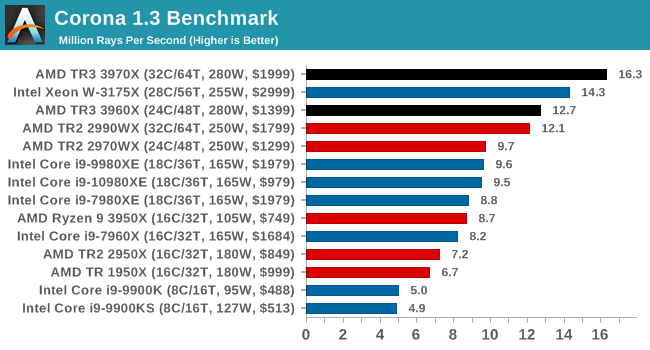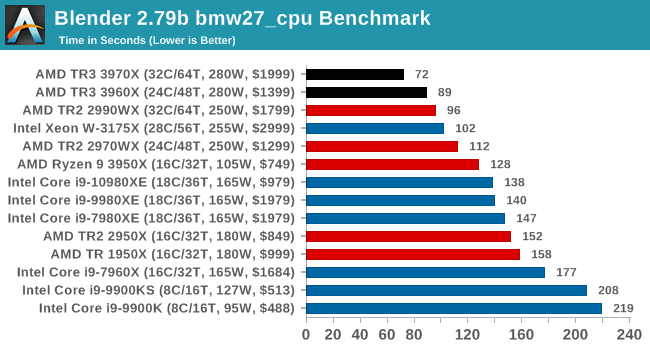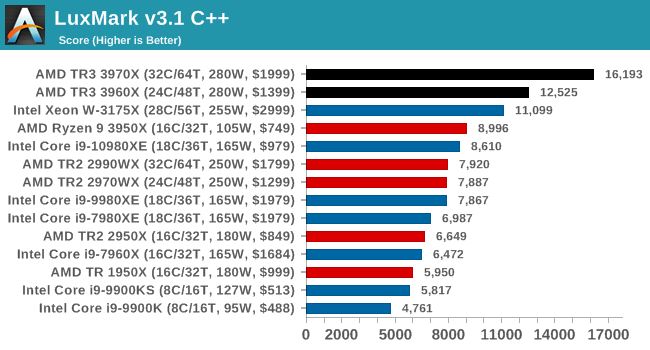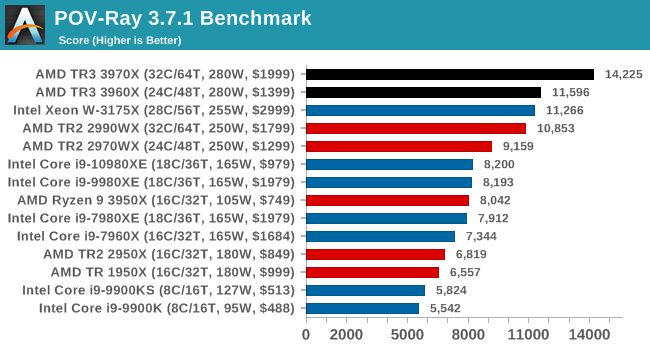The AMD Ryzen Threadripper 3960X and 3970X Review: 24 and 32 Cores on 7nm
by Dr. Ian Cutress, Andrei Frumusanu & Gavin Bonshor on November 25, 2019 9:05 AM ESTCPU Performance: Rendering Tests
Rendering is often a key target for processor workloads, lending itself to a professional environment. It comes in different formats as well, from 3D rendering through rasterization, such as games, or by ray tracing, and invokes the ability of the software to manage meshes, textures, collisions, aliasing, physics (in animations), and discarding unnecessary work. Most renderers offer CPU code paths, while a few use GPUs and select environments use FPGAs or dedicated ASICs. For big studios however, CPUs are still the hardware of choice.
All of our benchmark results can also be found in our benchmark engine, Bench.
Corona 1.3: Performance Render
An advanced performance based renderer for software such as 3ds Max and Cinema 4D, the Corona benchmark renders a generated scene as a standard under its 1.3 software version. Normally the GUI implementation of the benchmark shows the scene being built, and allows the user to upload the result as a ‘time to complete’.
We got in contact with the developer who gave us a command line version of the benchmark that does a direct output of results. Rather than reporting time, we report the average number of rays per second across six runs, as the performance scaling of a result per unit time is typically visually easier to understand.
The Corona benchmark website can be found at https://corona-renderer.com/benchmark

Being fully multithreaded, we see the order here follow core counts. That is except for the 32-core 2990WX sitting behind the 24-core 3960X, which goes to show how much extra performance is in the new TR generation.
Blender 2.79b: 3D Creation Suite
A high profile rendering tool, Blender is open-source allowing for massive amounts of configurability, and is used by a number of high-profile animation studios worldwide. The organization recently released a Blender benchmark package, a couple of weeks after we had narrowed our Blender test for our new suite, however their test can take over an hour. For our results, we run one of the sub-tests in that suite through the command line - a standard ‘bmw27’ scene in CPU only mode, and measure the time to complete the render.
Blender can be downloaded at https://www.blender.org/download/

We have new Threadripper records, with the 3970X almost getting to a minute to compute. Intel's nearest takes almost as long, but does only cost half as much. Again, the 3960X puts the 2990WX in its place.
LuxMark v3.1: LuxRender via Different Code Paths
As stated at the top, there are many different ways to process rendering data: CPU, GPU, Accelerator, and others. On top of that, there are many frameworks and APIs in which to program, depending on how the software will be used. LuxMark, a benchmark developed using the LuxRender engine, offers several different scenes and APIs.
In our test, we run the simple ‘Ball’ scene. This scene starts with a rough render and slowly improves the quality over two minutes, giving a final result in what is essentially an average ‘kilorays per second’.

Our LuxMark test again pushes both TR3 processors out in the lead.
POV-Ray 3.7.1: Ray Tracing
The Persistence of Vision ray tracing engine is another well-known benchmarking tool, which was in a state of relative hibernation until AMD released its Zen processors, to which suddenly both Intel and AMD were submitting code to the main branch of the open source project. For our test, we use the built-in benchmark for all-cores, called from the command line.
POV-Ray can be downloaded from http://www.povray.org/

More rendering, more wins for AMD. More losses for the 2990WX, even though on these tests it still beats the 10980XE quite easily.











245 Comments
View All Comments
Xyler94 - Tuesday, November 26, 2019 - link
No, Dell EMC and HPE have both gone Epyc, Amazon is getting Epycs, Azure is getting Epycs, Google's Stadia runs on Epyc (That's another discussion though). Lots of big names are running Epyc now. It takes years to validate server equipment, unlike the enthusiasts, who can afford a bit of downtime here and there, servers cannot. So they experiment with new hardware for a year or two before implementing it. Remember that the 1.5 Exaflop Supercomputer is gonna be powered by AMD CPUs also.AMD is making big wins, but it takes a lot of time for the numbers to show
Teckk - Monday, November 25, 2019 - link
True, but neither does living in denial. So Intel launched their HEDT for half the price they would've otherwise launched, why would they if it was so good and would sell like crazy?Ignoring problems like 10nm and just quoting numbers gets boring quickly.
Total Meltdowner - Monday, November 25, 2019 - link
It's only downhill now.Supercell99 - Tuesday, November 26, 2019 - link
Also, AMD earnings are $0.03 per share. So really INTL can give their chips away for a few years if they wanted and crush amd until they get the performance advantage again. I love that AMD is back we need competition, but lets be real. To think INTEL is out of this is idiotic.bigvlada - Wednesday, November 27, 2019 - link
You might want to read about what happened when American Tobacco Company tried to give products for free in order to crush the competition.Marburg U - Monday, November 25, 2019 - link
Hmmm, still on QX9770 here. Will wait the next gen.o_O
ShowsOn - Monday, November 25, 2019 - link
Your CPU is slower than the US$49 Athlon 3000G that AMD released last week.peevee - Tuesday, November 26, 2019 - link
Actually, that would be a fun comparison. 4 10 y/o cores @3.2, vs 2 1.5-y/o cores+SMT @3.5...Teckk - Monday, November 25, 2019 - link
Agree with you on the price, maybe a little too expensive?When is the next new (non-Skylake) Intel chip coming? Is that TigerLake or Saphire Rapids in 2021?
Irata - Monday, November 25, 2019 - link
When comparing prices, let's not forget that Intel prices are OEM (when buying 1,000) units whereas TR prices are MSRP.But looking at actual performance and platform features, I honestly cannot see anyone who is not already on X299 even paying that much.